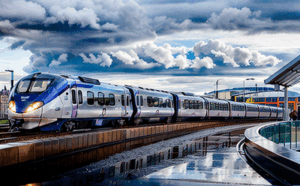Rail passengers across Perth and Kinross, along with those in Tayside, Fife, and Stirling, are set to benefit from significant reductions in travel costs following ScotRail’s decision to eliminate peak fares. As of today, September 1st, a new pricing structure is in effect, designed to make train travel more accessible and affordable for a wider range of journeys across the region.
This transformative change means an end to the higher charges previously levied during the busiest times of the day. Commuters and leisure travellers will now find that anytime single and return tickets are priced identically to their off-peak counterparts, simplifying fare calculations and offering substantial savings. Many anytime return tickets are seeing reductions of up to 50%, a welcome relief for household budgets. Understanding the New Fare Structure
For those travelling from key locations within Perthshire and beyond, the new system offers tangible financial advantages. Previously, peak fares were typically applied during morning rush hours, specifically before 9:15 AM, and again in the evening between 4:40 PM and 6:15 PM on weekdays. These time-based price hikes often made regular commuting or spontaneous travel prohibitively expensive for many. The removal of these charges aims to encourage greater use of public transport throughout the day.
It’s important to place this development in its broader context. The reintroduction of peak fares roughly a year ago, following a successful Scottish Government-funded trial of all-day off-peak rates, had been met with some public concern. This latest move by ScotRail represents a reversal of that policy, signaling a renewed focus on passenger affordability and convenience. However, a crucial detail for passengers to note is that overall fares across ScotRail’s network did experience a 3.8% increase in April. While this means the new off-peak rates are still higher than those during last year’s initial pilot, the elimination of the peak premium itself still translates into significant day-to-day savings for many. Significant Savings for Perth & Kinross Journeys
Residents of Perth can look forward to some of the most dramatic price drops on their regular routes. For example, an anytime return ticket from Perth to Glasgow, a popular route for both work and leisure, has seen an impressive reduction of 48%, falling from £41.60 to just £20.80. Similarly, travel from Perth to Edinburgh is now 40% cheaper, decreasing from £37.60 to £22.40. These savings could make a considerable difference to the weekly or monthly outgoings of many in our community.
Other key routes serving Perth and Kinross also show substantial decreases:
– A journey from Dundee to Perth now costs £11.20, down 31% from £16.30. – Travelling from Perth to Kirkcaldy will see a 45% reduction, from £21.70 to £12. – For those venturing north, Perth to Pitlochry tickets are now £18.70, an 18% decrease from £25.80. – The journey from Perth to Stirling, a vital link for many, boasts the highest saving, dropping by 50% from £21.70 to £10.80.
These price adjustments extend beyond Perth, benefiting neighbouring areas crucial to the region’s transport network. For instance, Dundee to Edinburgh fares are down 21% (£46.70 to £36.30), and Dundee to Glasgow sees an 18% drop (£60.20 to £49.60). Even Dunfermline to Edinburgh travel is now 39% cheaper, moving from £14 to £8.50. Implications for Local Life and Economy
The removal of peak fares is expected to have a ripple effect across Perth and Kinross. For residents, particularly those commuting to larger cities like Edinburgh or Glasgow, the financial relief could be substantial, freeing up disposable income for local spending in Perth’s shops, restaurants, and attractions. Families planning day trips to cultural sites in Edinburgh or shopping excursions in Glasgow will find these journeys more economically viable, encouraging greater exploration of Scotland’s central belt.
Beyond individual savings, this initiative could provide a subtle boost to the local economy. With more affordable travel, Perth could see an increase in visitors from surrounding areas, drawn by its historic city centre, vibrant cultural scene, and the scenic beauty of Kinross-shire. Businesses in Perth’s High Street, for instance, might experience a rise in footfall, while local hospitality providers could see a modest increase in patronage from day-trippers. Furthermore, encouraging train travel aligns with broader environmental goals, potentially reducing reliance on private vehicles and contributing to a greener Perth and Kinross.
As the changes come into effect, the local community in Perth and Kinross will undoubtedly be watching closely to see how these fare adjustments influence travel patterns and economic activity. The overarching goal of making train travel a more attractive and viable option for everyone in the region appears to be taking a significant step forward.
This transformative change means an end to the higher charges previously levied during the busiest times of the day. Commuters and leisure travellers will now find that anytime single and return tickets are priced identically to their off-peak counterparts, simplifying fare calculations and offering substantial savings. Many anytime return tickets are seeing reductions of up to 50%, a welcome relief for household budgets. Understanding the New Fare Structure
For those travelling from key locations within Perthshire and beyond, the new system offers tangible financial advantages. Previously, peak fares were typically applied during morning rush hours, specifically before 9:15 AM, and again in the evening between 4:40 PM and 6:15 PM on weekdays. These time-based price hikes often made regular commuting or spontaneous travel prohibitively expensive for many. The removal of these charges aims to encourage greater use of public transport throughout the day.
It’s important to place this development in its broader context. The reintroduction of peak fares roughly a year ago, following a successful Scottish Government-funded trial of all-day off-peak rates, had been met with some public concern. This latest move by ScotRail represents a reversal of that policy, signaling a renewed focus on passenger affordability and convenience. However, a crucial detail for passengers to note is that overall fares across ScotRail’s network did experience a 3.8% increase in April. While this means the new off-peak rates are still higher than those during last year’s initial pilot, the elimination of the peak premium itself still translates into significant day-to-day savings for many. Significant Savings for Perth & Kinross Journeys
Residents of Perth can look forward to some of the most dramatic price drops on their regular routes. For example, an anytime return ticket from Perth to Glasgow, a popular route for both work and leisure, has seen an impressive reduction of 48%, falling from £41.60 to just £20.80. Similarly, travel from Perth to Edinburgh is now 40% cheaper, decreasing from £37.60 to £22.40. These savings could make a considerable difference to the weekly or monthly outgoings of many in our community.
Other key routes serving Perth and Kinross also show substantial decreases:
– A journey from Dundee to Perth now costs £11.20, down 31% from £16.30. – Travelling from Perth to Kirkcaldy will see a 45% reduction, from £21.70 to £12. – For those venturing north, Perth to Pitlochry tickets are now £18.70, an 18% decrease from £25.80. – The journey from Perth to Stirling, a vital link for many, boasts the highest saving, dropping by 50% from £21.70 to £10.80.
These price adjustments extend beyond Perth, benefiting neighbouring areas crucial to the region’s transport network. For instance, Dundee to Edinburgh fares are down 21% (£46.70 to £36.30), and Dundee to Glasgow sees an 18% drop (£60.20 to £49.60). Even Dunfermline to Edinburgh travel is now 39% cheaper, moving from £14 to £8.50. Implications for Local Life and Economy
The removal of peak fares is expected to have a ripple effect across Perth and Kinross. For residents, particularly those commuting to larger cities like Edinburgh or Glasgow, the financial relief could be substantial, freeing up disposable income for local spending in Perth’s shops, restaurants, and attractions. Families planning day trips to cultural sites in Edinburgh or shopping excursions in Glasgow will find these journeys more economically viable, encouraging greater exploration of Scotland’s central belt.
Beyond individual savings, this initiative could provide a subtle boost to the local economy. With more affordable travel, Perth could see an increase in visitors from surrounding areas, drawn by its historic city centre, vibrant cultural scene, and the scenic beauty of Kinross-shire. Businesses in Perth’s High Street, for instance, might experience a rise in footfall, while local hospitality providers could see a modest increase in patronage from day-trippers. Furthermore, encouraging train travel aligns with broader environmental goals, potentially reducing reliance on private vehicles and contributing to a greener Perth and Kinross.
As the changes come into effect, the local community in Perth and Kinross will undoubtedly be watching closely to see how these fare adjustments influence travel patterns and economic activity. The overarching goal of making train travel a more attractive and viable option for everyone in the region appears to be taking a significant step forward.


